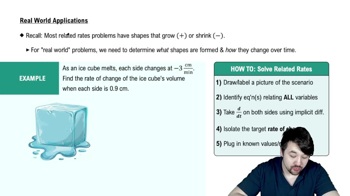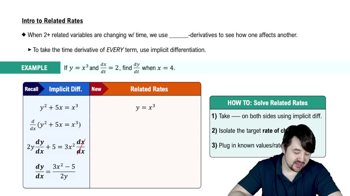Table of contents
- 0. Functions7h 52m
- Introduction to Functions16m
- Piecewise Functions10m
- Properties of Functions9m
- Common Functions1h 8m
- Transformations5m
- Combining Functions27m
- Exponent rules32m
- Exponential Functions28m
- Logarithmic Functions24m
- Properties of Logarithms34m
- Exponential & Logarithmic Equations35m
- Introduction to Trigonometric Functions38m
- Graphs of Trigonometric Functions44m
- Trigonometric Identities47m
- Inverse Trigonometric Functions48m
- 1. Limits and Continuity2h 2m
- 2. Intro to Derivatives1h 33m
- 3. Techniques of Differentiation3h 18m
- 4. Applications of Derivatives2h 38m
- 5. Graphical Applications of Derivatives6h 2m
- 6. Derivatives of Inverse, Exponential, & Logarithmic Functions2h 37m
- 7. Antiderivatives & Indefinite Integrals1h 26m
- 8. Definite Integrals3h 25m
4. Applications of Derivatives
Related Rates
Problem 5b
Textbook Question
A rectangular swimming pool 10 ft wide by 20 ft long and of uniform depth is being filled with water.
b. At what rate is the volume of the water increasing if the water level is rising at 1/4ft/min.
 Verified step by step guidance
Verified step by step guidance1
Identify the dimensions of the pool: width = 10 ft, length = 20 ft, and let the depth of the water be h ft.
Calculate the volume V of the water in the pool using the formula for the volume of a rectangular prism: V = length × width × height, which gives V = 20 ft × 10 ft × h ft.
Differentiate the volume V with respect to time t to find the rate of change of volume: dV/dt = 20 ft × 10 ft × (dh/dt), where dh/dt is the rate at which the water level is rising.
Substitute the given rate of change of height, dh/dt = 1/4 ft/min, into the differentiated volume equation to find dV/dt.
Calculate dV/dt to determine the rate at which the volume of water is increasing in the pool.
Recommended similar problem, with video answer:
 Verified Solution
Verified SolutionThis video solution was recommended by our tutors as helpful for the problem above
Video duration:
3mPlay a video:
Was this helpful?
Related Videos
Related Practice






